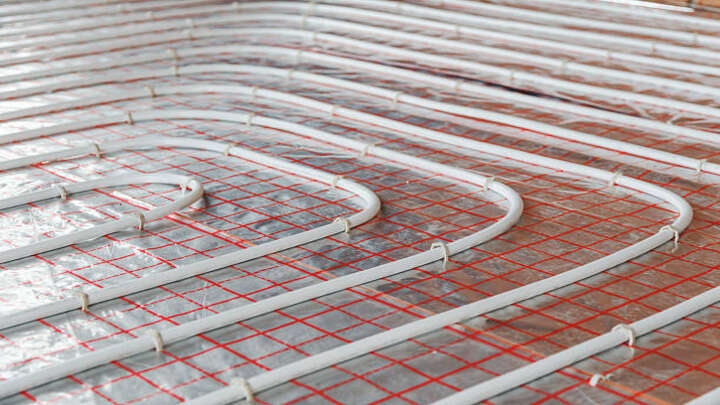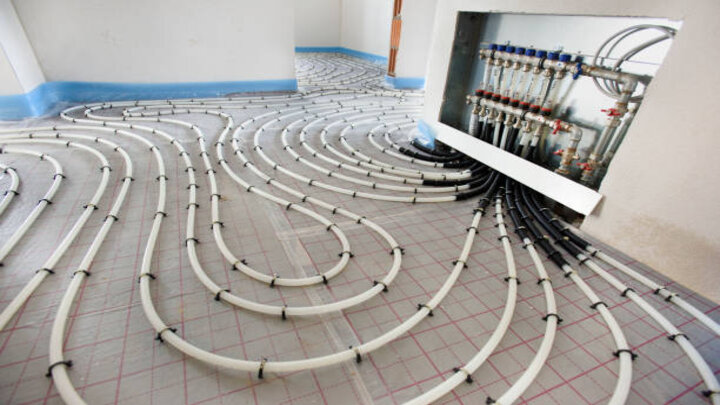No one likes coming down from the warm and cosy bed or shower and stepping on a cold and icy floor. This is where having radiant floor heating installed seems like a good idea. It is one of the best ways to heat the house without much noise, clanking at night, or vent whooshing.
But before you commence this project, you have to get more insights into radiant floor heating. This guide will discuss how radiant floor heating works, the benefits, downsides, types, and more. So without taking too much of your time, let’s dive right into it.
What Is Radiant Floor Heating And How Does It Work?
Radiant floor heating, which is also termed Underfloor Heating (UFH) is a type of heating system installed underneath the flooring of a room. It works by circulating either hot water through designated pipes or by electrical heating cables that have been installed underneath the floor.
The heat that emits is then absorbed by other objects in the room which helps warms the entire space efficiently. So, to put it in simple terms, underfloor heating uses radiant heat technology to heat the floors. Afterwards, the heat rises throughout the entire room.
Advantages Of Radiant Floor Heating
Radiant floor or underfloor heating holds many more advantages than the traditional radiator. Some key advantages include the following.
1. Virtually invisible to the eyes
Unlike the traditional HVAC system, radiators, space heaters, or other heating options, underfloor heating is installed completely under the floor. It also operates under the floor, making it effectively invisible and discreet. As a result, they are an aesthetically pleasing heating option for your home.
2. Energy-efficient and cost-effective
Radiant floor heating is one of the most energy-efficient and cost-effective heating systems available today. Most traditional radiators will have to be heated as high as 167 degrees Fahrenheit for them to be able to work effectively. For underfloor heating, the system only has to get around 84 degrees Fahrenheit and they will work effectively.
3. Flexibility and compatibility
RFH can be installed in just about any type of building or location in the building. It can be installed upstairs or downstairs, in new building construction, during renovations, or even extensions. You can also have it installed in specific rooms or the entire house. What’s more? RFH is also compatible with most types of floor types, including; wood, tiles, laminate, and vinyl.
4. Easy operation and low maintenance need
After the installation of the underground heating system, it is pretty much just smooth sailing. You can control the temperature and the heat schedule for your home from a smart thermostat. You will also require very little occasional maintenance which is far better than radiators and other heating systems that may need repairs and cleaning from time to time.
5. Safety
As earlier mentioned, one of the perks of RFH is that it is completely invisible since it is done underneath the floor. This is very crucial as it is safer than most other heating systems like radiators with sharp edges and boiling points one has to be cautious so the young ones don’t get hurt.
Drawbacks Of Radiant Floor Heating
As with every other product, there are drawbacks or limitations to them and RHFs aren’t an exception. Some of the drawbacks allocated to them are;
1. Purchase cost
As the adage says, nothing good comes cheap; the cost of purchasing RHF is, without a doubt, not pocket change. That said, it is worth noting that even with the purchase cost, you will save more in the long run. That is; taking into consideration that you will spend less on your heating bills.
2. Installation cost
After purchasing the RFH system, you will also have to spend extra on installation and this may incur more expenses, depending on the size of the project. But also keep in mind that having this installed in your home will automatically increase the resale value of your home.
3. Installation time
Unlike getting a normal radiator that will just require hours to install, installing of radiant floor heating system may take a little bit of time. Depending on how experienced the installer works and the size of the home, it may take around 2 to 3 days for it to be installed completely.
4. Removing and replacing old flooring
Although this does not apply to everybody, it is still worth noting. If it is a case of installing the RFH on an already installed floor, you have to remove and replace the old floor. This may incur more costs and also take longer for the project to be completed.
5. Floor height issue
RFH is normally installed underneath the floor. This consists of adding a layer of compacted sand, insulation board, tubing, etc. This will, unfortunately, add another inch or two to the floor and cause a slight loss of height.
Types Of Radiant Floor Heating
There are two major types of underfloor heating and each has its own unique properties. They include Hydronic Radiant Floor Heating and Electric Radiant Floor Heating. Let’s talk about them a bit, shall we?
1. Hydronic Radiant Floor Heating System

Also termed Warm Water/Wet Underfloor Heating, uses heating pipes under the floor. These pipes (Plastic PEX tubing) carry water that is heated by a boiler or water heater. The plastic PEX tubing can either be set above the subfloor (in grooves), buried in concrete, or clipped to the bottom of the floor.
2. Electric Radiant Floor Heating System

Just like the name implies, an electric radiant floor heating system uses electricity (that is, electric heating wires or cables concealed in pipes) to heat the floor. These electric cables (usually in a mat) are installed above the subfloor, in thin-set mortar.
Electric vs Hydronic Radiant Floor Heating – Which is best?
Both electric and hydronic RFH systems are top-notch systems, but when compared; Hydronic is often considered as the best option. Although it costs more to purchase and install than electric RFH, running a Hydronic RFH system will cost less than 3x the cost of running an electric RFH system. So in the long run, Hydronic RFH is the best.
FAQs
How long does radiant floor heating last?
Typically their lifespan is between 20 – 50 years, perhaps even longer is maintained adequately.
Is radiant floor heating expensive to run?
No, it is not. The running cost is relatively low compared to other heating methods.
Is underfloor heating safe?
Yes, they are. Whether electric or Hydronic floor heating is a safe form of heating.
Conclusion – Is radiant floor heating worth it?
Floor heating is the modern heating method for most homes now, creating the perfect temperature from the moment you enter the room. They are safe, aesthetically pleasing, easy to operate, and compatible with various floor types.
It might cost a lot of money to buy and install this system, but in the long run, you will spend less on heating bills, and the resale value of your home is certain to appreciate. So yes, it is definitely worth it.
I hope you enjoyed reading this article. For more interesting content, visit our blog page now.
Thanks for reading.